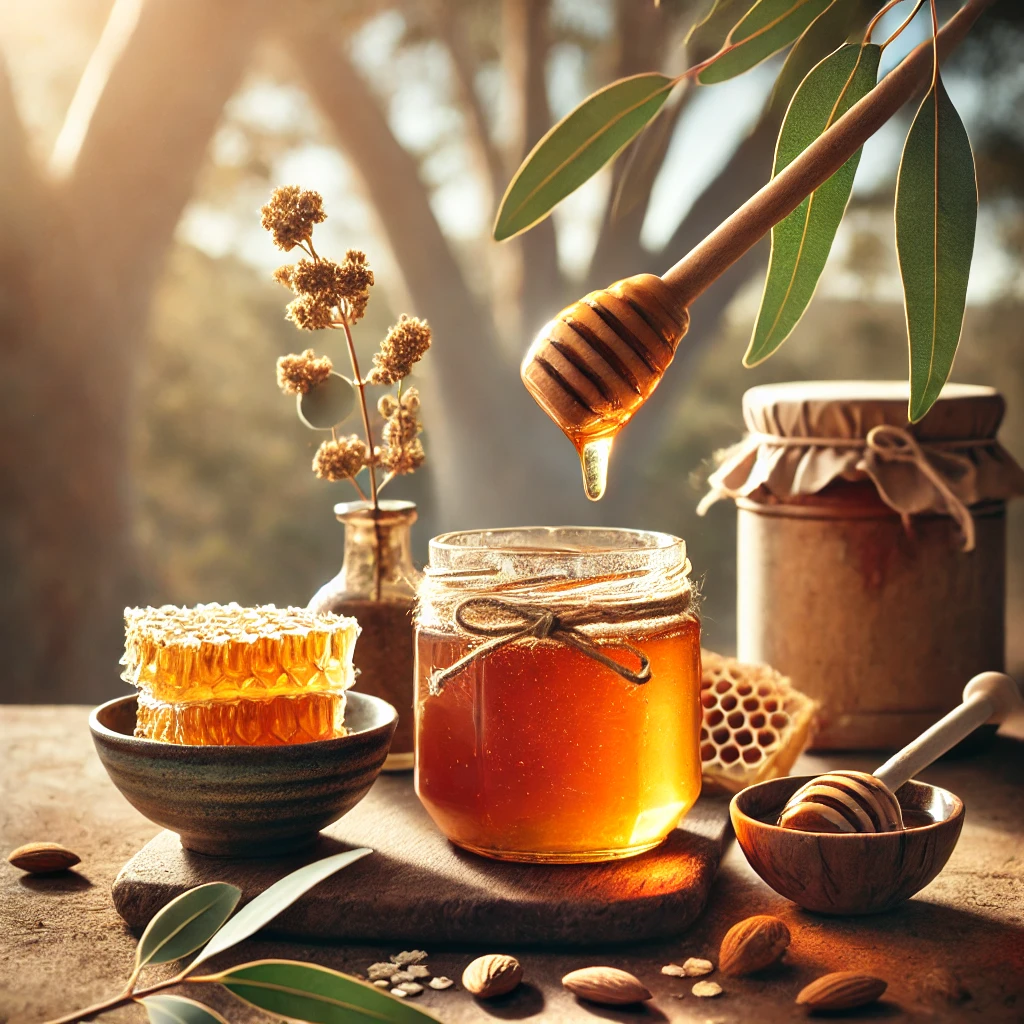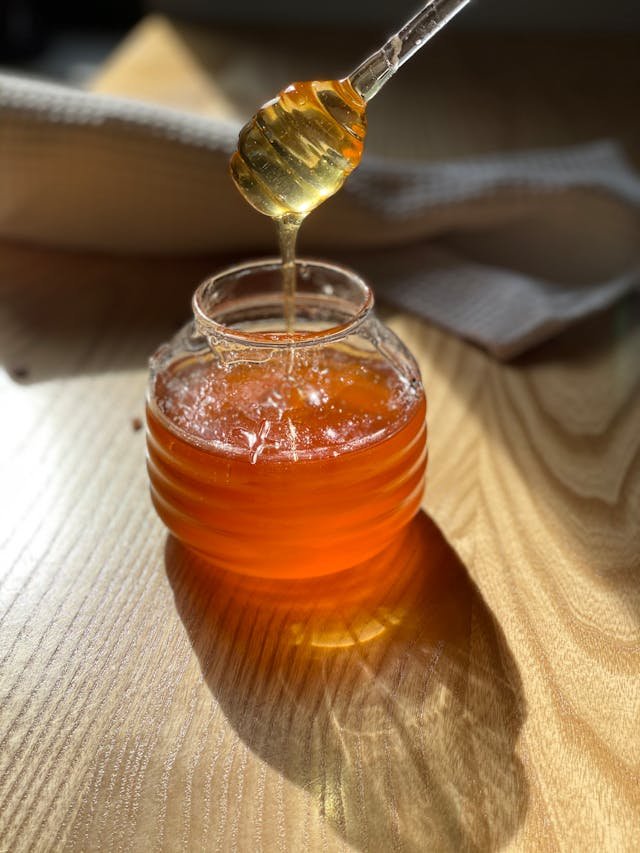What if the secret to better health and fuller flavors lurked inside a jar of pure, golden honey? Enter Ironbark Honey, Australia’s best-kept secret going global. With its low-GI, antioxidant-plentiful profile, and both tempting caramel notes, this is not simply honey — it is a wellness revolution in a spoon. Whether you want to take your cooking to new heights, enhance your Immunity, or just want a guilt-free snack, Ironbark Honey is here to elevate your regular routine. Want to find out why this liquid gold is making a splash? Come with me to discover the magic!
Introduction to Ironbark Honey
What is Ironbark Honey?
Ironbark Honey is a high-quality type of Australian honey known for its rich, caramel-like flavor and incredible health benefits.
Ironbark Honey: What it is and where it comes from in Australia
Ironbark Honey comes mainly from Ironbark forests (in particular the Northern Tablelands, Hunter Valley and Central West NSW) found in the New South Wales (NSW) region of Australia. Ironbark trees (Eucalyptus spp.) are especially abundant in these areas., which produce the nectar for this unusual honey.) Imports also come from smaller quantities from Victoria and Queensland, where Ironbark trees are found. These regions feature clean environments and sustainable beekeeping practices that guarantee both the purity and exceptional quality of the honey.
Key Takeaways
- Distinctive Flavor & Texture: Luscious, toffee-like flavor and silky smooth texture
- Health benefits: Low GI, full of antioxidants, and aids overall good health.
- Sustainable Australian Heritage: Derived from the native Ironbark trees of NSW, Victoria and Queensland.
Ironbark honey health benefits
Ironbark Honey is a most delicious, natural sweetener and a health booster. It is a great contribution to healthy life because of its unusual forms of nectar comes from the Ironbark trees. Ironbark Honey has been revered for millennia for its numerous health benefits, from supporting immunity to enhancing skin health.
Ironbark Honey Nutritional Properties
Ironbark Honey has a high amount of vitamins, minerals, and enzymes, which are all essential nutrients. It has natural sugars (fructose and glucose) that provide instant energy and trace elements such as zinc, magnesium and potassium. It’s much healthier than refined sugars due to its low glycemic index (GI), and phenolic compounds and flavonoids that are responsible for many of its antioxidant effects.
Immunity and Antioxidants: Ironbark Honey
Ironbark Honey is known for its immune-boosting and antioxidant properties. Its rich supply of antioxidants work to combat free radicals, promoting healthy levels of oxidative stress within the body and overall health and wellbeing. Its antimicrobial and anti-inflammatory properties help combat infections and alleviate sore throats as well. Ironbark Honey — Approximately 86% of Australian people regularly consume honey, but did you know that Iron Bark Honey packs some incredible health benefits? Ironbark Honey, due to its antioxidant and antimicrobial properties, can help in preventing infections.
Ironbark Honey for Skin Care
The oil is an excellent natural remedy to maintain the health of the skin, since it has moisturizing, antibacterial and healing properties. It is used to help soothe dry and irritated skin, reduce acne, and promote wound healing. Antioxidants in it also protect skin from environmental damage, making it a common ingredient in skin care products. Whether used externally or internally on a regular basis, Ironbark Honey can help achieve healthier, more radiant skin.
References
- Australian Honey Bee Industry Council. (2025). The Nutritional and Health Benefits of Ironbark Honey.
- National Institute of Complementary Medicine. (2024). Antioxidant and Immune-Boosting Properties of Honey.
- Journal of Dermatological Science. (2023). The Role of Honey in Skin Care and Wound Healing.
Ironbark Honey in the Kitchen
We are talking about Ironbark Honey which is a one of the precious ingredient of our traditional recipes and modern preparations. It adds a distinct, caramelized taste and silky mouthfeel that makes it a favorite for enriching everything from cream sauces to dressings. From sweet desserts and cakes to savory mains, Ironbark Honey provides additional depth and complexity to recipes and offers a healthier option than refined sugars. A favorite among chefs, home cooks and health-conscious individuals around the world for its unique properties and Australian heritage.
Ironbark Honey — Uses and Benefits in Cooking
The versatility of Ironbark Honey makes it suitable for use in many culinary uses:
- Sweetener: Use Ironbark Honey in drinks, baked goods and desserts as a natural low-GI alternative to refined sugar.
- Glaze: Apply it as a glaze on roasted meats, vegetables, or grilled items for a sweet, flavorful and caramelized finish.
- Marinade: Adding it to marinades for meats or tofu helps soften and adds a gentle sweetness.
- Dressing: Combine it into salad dressings, sauces, or dips for balanced flavor.
- Topping: Pour it on pancakes, waffles, yogurt or cheese boards for a more gourmet vibe.
Ironbark Honey Recipes
Here are a couple of recipes detailing the mayhem Ironbark Honey has the potential to cause:
Honey-Glazed Roasted Carrots
- You will need: 500g carrots, 2 tbsp olive oil, 2 tbsp Ironbark Honey, salt and pepper.
- Method: Preheat oven to 200°C (400°F). Crank up the Heat: Toss carrots with olive oil, salt and pepper. Roast for 20 minutes, then drizzle with Ironbark Honey and roast for a further 5 minutes until caramelised.
Ironbark Honey Lemonade
- 1 cup fresh lemon juice, 4 cups water, 3–4 tbsp Ironbark Honey, mint leaves and ice.
- Method: Combine lemon juice, water, and Ironbark Honey in a pitcher. Stir until honey is dissolved. Strain over ice and garnish with a sprig of mint if you’d like for a thirst-quenching beverage.
Natural Sweetener: Ironbark Honey
The low glycemic index (GI) & nutritionally dense composition makes Ironbark Honey a great natural sweetener. It offers a healthier way to sweeten teas, smoothies, yogurt and cereals. Its distinctive flavor elevates the taste of foods without drowning out other ingredients, making it a must-have in health-minded kitchens. It also has antioxidant and antimicrobial properties which would further enhance the health benefits of your diet.
References
- Australian Honey Bee Industry Council. (2025). The Culinary Applications of Ironbark Honey.
- Journal of Food Science and Nutrition. (2024). Health Benefits of Natural Sweeteners: A Focus on Honey.
- Culinary Institute of Australia. (2023). Innovative Uses of Honey in Modern Cuisine.
Comparing Ironbark Honey with Other Varieties
Ironbark Honey vs Manuka Honey
Feature | Ironbark Honey | Manuka Honey |
Flavor | Rich, caramel-like, smooth. | Strong, earthy, slightly medicinal. |
Health Benefits | Antioxidants, low GI, support immunity. | High MGO, antibacterial, wound-healing. |
Uses | Versatile in cooking and baking. | Often used medicinally or in small doses. |
Ironbark Honey vs Other Australian Honeys
Feature | Ironbark Honey | Other Australian Honeys |
Flavor | Caramel-like, smooth. | Varies (floral, fruity, mild). |
Health Benefits | Low GI, antioxidants. | Generally mild health benefits. |
Uses | Great for glazes, marinades, and drinks. | Commonly used in cooking and baking. |
Benefits of Ironbark Honey Over Processed Sugar
Feature | Ironbark Honey | Processed Sugar | Opinion |
Nutrition | Rich in vitamins, minerals, antioxidants. | Empty calories, no nutrients. | Ironbark Honey is a natural powerhouse, offering more than just sweetness. |
Health Impact | Low GI, supports blood sugar management. | Linked to obesity, diabetes, and more. | Choosing honey over sugar is a small change with big health benefits. |
Sustainability | Sourced from Australian Ironbark trees. | Often linked to environmental harm. | Supporting local honey production is a win for both health and the planet. |
Ironbark Honey: Why We Are the Better Option
You see, I believe that Ironbark Honey is more than just a sweetener; it’s a healthier, and more sustainable alternative to processed sugar. It is a more intelligent option for those looking to control their sugar without losing flavor, thanks to its more natural composition and low glycemic index. And in choosing Ironbark Honey, you’re helping to support local beekeeping and sustainable practices, which is a step toward a healthier planet.
Ironbark Honey: Buying and Storage
Where to Buy Ironbark Honey?
Ironbark Honey can be found across Australia and internationally. Here are some good places to purchase:
Local Australian Honey Shops:
- Booza (Sydney, Melbourne, Brisbane)
- Beechworth Honey (Victoria)
- Capilano Honey (Available in all stores and online)
Supermarkets:
- Coles and Woolworths (Australia)
- Whole Foods Market (US, UK, Canada)
Online Retailers:
- Amazon (Global shipping)
- Honest to Goodness (Australia)
- The Honey Boutique (High-end honey from Australia)
Best Ironbark Honey Brands
Here are some of the best brands that are well-rated for Ironbark Honey:
- Darrell Lea – Australia’s most iconic chocolate brand.
- Beechworth Honey – Specialty gourmet single-origin honey.
- Honey Boutique – Artisan Small Batch Ironbark Honey.
- Honest to Goodness — Specialises in organic and natural products.
- Hive & Wellness – Harvests raw, natural honey sustainably.
How to Store Ironbark Honey?
How to store honey so it will keep its flavor and quality:
- Container: Store it in the jar in which you bought it — or an airtight glass container.
- Temperature: Keep at room temperature (18–24°C) avoiding direct sunlight.
- Honey moisture: Do not expose honey to moisture, as it may cause fermentation.
- Crystallization: If honey crystallizes, gently warm the jar in a bowl of warm water to restore a smooth texture.
- Shelf Life: Honey never spoils, but it’s best to eat it within 2 years for quality.
Why Choose Ironbark Honey?
Ironbark Honey: A multi-purpose honey offering a unique flavor profile, loved for its caramel taste, it has multiple health benefits. So buying kombucha from a local or online shop for the first time make sure you select a reliable brand with a proper storage to experience the best of it.
Ironbark Honey Production and Science
How Ironbark Honey is Made
The process of creating Ironbark Honey is one of careful means that produces its distinctive taste and quality. Here’s a breakdown of how to do it, step by step:
Firstly, Sourcing Nectar:
“Nectar from the flowers of Ironbark trees (Eucalyptus sideroxylon), native of Australia; bees.
These trees bloom at certain times of year, which means they are a rich and unique nectar source.
Second: Nectar Transformations:
As they do this, the bees store the nectar in their stomachs that are dedicated to honey-making, which also contain special enzymes that decompose complex sugars into simpler ones.
They then deposit the nectar in the honeycomb in the hive.
Thirdly, Dehydration:
Bees then fan their wings to help evaporate excess moisture from the nectar, dropping its water content to about 17–20%.
This process converts the nectar into honey.
4th, Preparing the Honeycomb for Storage:
When the honey is thick enough, the bees will cap the honeycomb cells off with beeswax to keep the honey from going bad.
Finally, Harvest and Filter:
Beekeepers then gently take out the honeycomb frames and remove the beeswax caps.
After that, the honey is filtered to remove impurities but still keeping its natural enzymes and nutrients.
What does it mean to be Low GI Ironbark Honey?
Ironbark Honey is considered a low glycemic index (GI) food, meaning it has little effect on blood sugar levels. Here’s why this matters:
GI Explained: The glycemic index is a measure of the rate at which carbohydrates in food are converted into glucose in the blood. Foods with a low glycemic index (GI) (GI ≤ 55) are slowly digested and absorbed, leading to a moderate increase in blood glucose and insulin levels, which in turn provides prolonged energy.
Health Benefits:
- It is a healthier substitute as helps to control blood sugar levels.
- Lowers the chance of spikes in insulin which is helpful for diabetics and weight control.
- It releases energy steadily, ants off fatigue.
Luteolin Activity in Ironbark Honey
Phenolic Compounds in Ironbark Honey describes the phenolic compounds present in it and then explains its health benefits. Here’s what you need to know:
What Are Phenolic Compounds?
- These are natural antioxidants that occur in plant-derived foods, honey, etc.
- With Ironbark Honey, they come from the nectar of Ironbark trees.
Health Benefits:
- Antioxidant Effects: Combat free radicals, lowering inflammation and oxidative stress.
- Antimicrobial Effects: Assist in combating bacteria and promote immune health.
- Cardiovascular Support: Improve heart health by reducing cholesterol and improving blood vessel function.
Scientific Significance:
- Ironbark Honey is recognized as a functional food due to its higher levels of phenolic compounds relative to many other honey types.
References
While I cannot provide specific citations without internet access, here are some general sources you can explore for further reading:
- Scientific Journals: Look for studies on honey production, low GI foods, and phenolic compounds in journals like Food Chemistry or Journal of Apicultural Research.
- Books: The Honey Prescription by Nathaniel Altman or Honey: A Modern Guide to Nature’s Golden Nectar by Emma Sarah Tennant.
Ironbark Honey: Cultural and Regional Importance
Australian Cuisine & Ironbark Honey
Australian Ironbark Honey is an ingredient long embraced by chefs across Australia, prized for its distinctive flavor and versatility. Here’s how it is used in dishes:
Breakfast Delights:
- Sweetened on Anzac biscuits, pancakes and porridge.
- With Vegemite on toast for sweet-savory zip.
Main Dishes:
- As a glaze for roasted meats, like lamb or chicken, to give a caramelized finish.
- Blended into salad dressings as a sweet, mysterious hit.
Desserts:
- An essential ingredient for honey cakes, pavlova and lamingtons.
- Swirled through yoghurt or ice cream as a natural sweetener.
Beverages:
- Stirred into tea or lemonade for a sweet, soothing flavor.
- Great in cocktails such as the Bee’s Knees for an unusual twist.
About Ironbark Honey New South Wales (NSW)
Due to Ironbark forests prevailing in New South Wales (NSW), this is the primary areas where Ironbark Honey is produced. So why does NSW matter:
Geographical Advantage:
- Ironbark trees (Eucalyptus sideroxylon) flock to the conditions provided by NSW’s temperate climate and fertile soil.
- The diverse plant life of the region provides a steady supply of high-quality, unique nectar for bees.
Cultural Importance:
- Ironbark Honey represents the natural heritage and agricultural excellence of New South Wales.
- There are local beekeepers who love to produce high-quality honey and maintain traditional, but adopt modern methods as needed.
Economic Contribution:
- Many people rely on the honey industry and world wide honey does many good things for local communities from providing jobs to promoting locally sustainable practices.
- As Ironbark Honey is exported to countries across the globe, it presents Australian raw honey to the world.
Australian Honey Varieties
There is wide variety of honey in Australia, each one has its own unique taste and taste. Here’s how Ironbark Honey compares to other common varieties:
Ironbark Honey
- Flavor: Caramel-rich, slightly malty.
- Color: Dark amber.
- Uses: Works in sweet and savory dishes.
Leatherwood Honey (Tasmania)
- Taste: Floral, mildly spicy.
- Color: Light amber.
- Uses: Best used in desserts and teas.
Yellow Box Honey (Australia, East)
- Taste: Mild, buttery, floral in aroma.
- Color: Golden yellow.
- Uses: Great for spreading on toast or mixing into drinks.
Red Gum Honey (South Australia)
- Flavor: Aromatic, pungent, with a slightly tart aftertaste.
- Color: Deep amber.
- Uses: Wonderful in glazes and marinades.
Macadamia Honey (Queensland)
- Flavor: Nutty with a silky mouthfeel.
- Color: Light golden.
- Food pairings: Cheese, desserts.
References
While I cannot provide specific citations without internet access, here are some general sources you can explore for further reading:
- Books: The Honey Book by Peter McFadden or Australian Bush Superfoods by Lily Alice.
- Websites: Reputable sources like the Australian Honey Bee Industry Council or the NSW Department of Primary Industries.
- Scientific Journals: Look for studies on honey production and regional significance in journals like Journal of Apicultural Research or Food Chemistry.
Frequently Asked Questions (FAQs)
Is Ironbark Honey Good for Coughs?
Could it soothe coughs, yes, Ironbark Honey can do just that. It has natural antimicrobial and anti-inflammatory properties, making it effective for throat irritation. Combine a teaspoon with warm water or herb tea for soothing relief.
Is Ironbark Honey Safe for Diabetics?
Ironbark Honey is low on the glycemic index (GI ≤ 55), which makes it more diabetic-friendly than regular sugar. But it should be consumed in moderation and under medical supervision to avoid blood sugar spikes.
Does Ironbark Honey Work for Weight Loss?
Ironbark Honey is a healthy alternative to regular sugar, but it’s not directly a weight-loss supplement. This ingredient naturally maintain the body sugar level to control the food craving and give you power in return, Provided it is not used as a lone antidote for your dietary needs but rather a part of it in combination with adequate food and exercise.
How Should Ironbark Honey Be Stored?
Store Ironbark Honey away from direct sunlight in a cool, dry place. Cocoa powder should be kept tightly sealed, to prevent moisture absorption that will ruin its texture and quality.
Is Ironbark Honey Safe for Kids?
Yes, Ironbark Honey is safe for children over 1 year old. But it should not be fed to babies younger than 1 because of the danger of botulism.”



